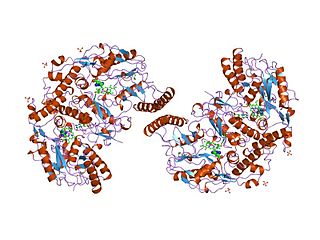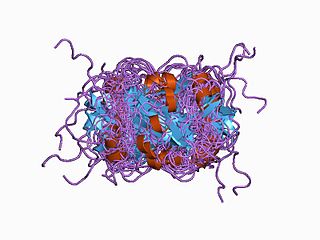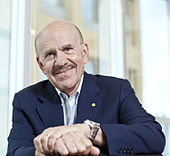
Ferid Murad was an American physician and pharmacologist, and a co-winner of the 1998 Nobel Prize in Physiology or Medicine.

Robert Francis Furchgott was a Nobel Prize-winning American biochemist who contributed to the discovery of nitric oxide as a transient cellular signal in mammalian systems.

Guanylate cyclase is a lyase enzyme that converts guanosine triphosphate (GTP) to cyclic guanosine monophosphate (cGMP) and pyrophosphate:

The Endothelium-derived relaxing factor (EDRF) is a strong vasodilator produced by cardiac endothelial cells in response to stress signals such as high levels of ADP accumulation or hypoxia. Robert F. Furchgott is widely recognised for this discovery, even going so far as to be a co-recipient of the 1998 Nobel Prize in Medicine with his colleagues Louis J. Ignarro and Ferid Murad. Nitric oxide (NO) is a key component in any EDRF as these compounds either include NO or are structurally in the form of NO.

Nitric oxide synthases (NOSs) are a family of enzymes catalyzing the production of nitric oxide (NO) from L-arginine. NO is an important cellular signaling molecule. It helps modulate vascular tone, insulin secretion, airway tone, and peristalsis, and is involved in angiogenesis and neural development. It may function as a retrograde neurotransmitter. Nitric oxide is mediated in mammals by the calcium-calmodulin controlled isoenzymes eNOS and nNOS. The inducible isoform, iNOS, involved in immune response, binds calmodulin at physiologically relevant concentrations, and produces NO as an immune defense mechanism, as NO is a free radical with an unpaired electron. It is the proximate cause of septic shock and may function in autoimmune disease.

Sir Salvador Enrique Moncada Seidner, FRS, FRCP, FMedSci is a Honduran pharmacologist and professor. He is currently Research Domain Director for Cancer at the University of Manchester.

Nicorandil is a vasodilator drug used to treat angina.

Endothelial NOS (eNOS), also known as nitric oxide synthase 3 (NOS3) or constitutive NOS (cNOS), is an enzyme that in humans is encoded by the NOS3 gene located in the 7q35-7q36 region of chromosome 7. This enzyme is one of three isoforms that synthesize nitric oxide (NO), a small gaseous and lipophilic molecule that participates in several biological processes. The other isoforms include neuronal nitric oxide synthase (nNOS), which is constitutively expressed in specific neurons of the brain and inducible nitric oxide synthase (iNOS), whose expression is typically induced in inflammatory diseases. eNOS is primarily responsible for the generation of NO in the vascular endothelium, a monolayer of flat cells lining the interior surface of blood vessels, at the interface between circulating blood in the lumen and the remainder of the vessel wall. NO produced by eNOS in the vascular endothelium plays crucial roles in regulating vascular tone, cellular proliferation, leukocyte adhesion, and platelet aggregation. Therefore, a functional eNOS is essential for a healthy cardiovascular system.

Nitric oxide synthase, inducible is an enzyme which is encoded by the NOS2 gene in humans and mice.

Nitric oxide synthase 1 (neuronal), also known as NOS1, is an enzyme that in humans is encoded by the NOS1 gene.

Calcium/calmodulin-dependent protein kinase type 1 is an enzyme that in humans is encoded by the CAMK1 gene.

Guanylate cyclase soluble subunit beta-1 is an enzyme that in humans is encoded by the GUCY1B3 gene.

Guanylate cyclase soluble subunit alpha-3 is an enzyme that in humans is encoded by the GUCY1A3 gene.

Guanylate cyclase soluble subunit alpha-2 is an enzyme that in humans is encoded by the GUCY1A2 gene.

7-Nitroindazole, or 7-NI, is a heterocyclic small molecule containing an indazole ring that has been nitrated at the 7 position. Nitroindazole acts as a selective inhibitor for neuronal nitric oxide synthase, a hemoprotein enzyme that, in neuronal tissue, converts arginine to citrulline and nitric oxide (NO). Nitric oxide can diffuse through the plasma membrane into neighbouring cells, allowing cell signalling, so nitroindazole indirectly inhibits this signalling process. Other inhibitors exist such as 3-bromo-7-nitroindazole, which is more potent but less specific, or NPA (N-propyl-L-arginine), which acts on a different site.
Biological functions of nitric oxide are roles that nitric oxide plays within biology.
Ted M. Dawson is an American neurologist and neuroscientist. He is the Leonard and Madlyn Abramson Professor in Neurodegenerative Diseases and Director of the Institute for Cell Engineering at Johns Hopkins University School of Medicine. He has joint appointments in the Department of Neurology, Neuroscience and Department of Pharmacology and Molecular Sciences.

Jonathan Solomon Stamler is an English-born American physician and scientist. He is known for his discovery of protein S-nitrosylation, the addition of a nitric oxide (NO) group to cysteine residues in proteins, as a ubiquitous cellular signal to regulate enzymatic activity and other key protein functions in bacteria, plants and animals, and particularly in transporting NO on cysteines in hemoglobin as the third gas in the respiratory cycle.

David Kass, M.D. is the Abraham and Virginia Weiss Professor of Cardiology at Johns Hopkins University. He also serves as a Professor of Medicine, Pharmacology, Molecular Sciences, and Biomedical Engineering. He obtained a Bachelor of Arts degree from Harvard College in 1975, majoring in Applied Physics and Engineering, and a Doctor of Medicine degree from Yale University in 1980. Following his medical studies, he completed an Internal Medicine residency at George Washington University in Washington, DC before joining the Cardiology Division at Johns Hopkins University. Kass' research has ranged from fundamental molecular and cellular studies to human clinical research. His publication record includes over 550 original papers, with more than 55,000 citations.

















